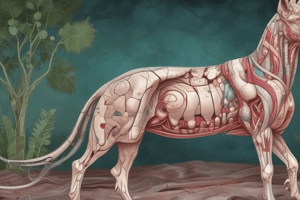Podcast
Questions and Answers
Which anatomical region is primarily involved in understanding respiratory and circulatory functions?
Which anatomical region is primarily involved in understanding respiratory and circulatory functions?
- Thorax (correct)
- Head and Neck
- Abdomen
- Pelvis
What is the primary focus of surface anatomy in veterinary practices?
What is the primary focus of surface anatomy in veterinary practices?
- Locating metabolic organs
- Identifying bony landmarks and soft tissue structures (correct)
- Studying reproductive health
- Understanding internal organ functions
Which region of the body contains the liver, spleen, and kidneys?
Which region of the body contains the liver, spleen, and kidneys?
- Pelvis
- Abdomen (correct)
- Thorax
- Limbs
Why is knowledge of variations among species significant in veterinary practices?
Why is knowledge of variations among species significant in veterinary practices?
Which anatomical region is primarily associated with locomotion and load-bearing?
Which anatomical region is primarily associated with locomotion and load-bearing?
What is a critical application of regional anatomy in clinical settings?
What is a critical application of regional anatomy in clinical settings?
Which technique is practiced to assess health and locate abnormalities in veterinary medicine?
Which technique is practiced to assess health and locate abnormalities in veterinary medicine?
Which of the following structures is NOT typically included in the head and neck region?
Which of the following structures is NOT typically included in the head and neck region?
Flashcards are hidden until you start studying
Study Notes
Regional Anatomy in Gross Veterinary Anatomy
-
Definition: Regional anatomy focuses on the study of specific areas of the body, examining the relationships between different structures.
-
Key Regions:
-
Head and Neck:
- Structures include skull, teeth, jaw, and cervical vertebrae.
- Important for understanding dental health, respiratory functions, and neurology.
-
Thorax:
- Contains the rib cage, heart, lungs, and major blood vessels.
- Critical for respiratory and circulatory functions.
-
Abdomen:
- Houses digestive organs (stomach, intestines), liver, spleen, and kidneys.
- Important for gastrointestinal health and metabolic functions.
-
Pelvis:
- Includes pelvic bones, reproductive organs, and urinary bladder.
- Key for understanding reproductive health and urinary functions.
-
Limbs (Forelimbs and Hindlimbs):
- Forelimbs: Includes shoulder, elbow, carpal joints, and bones (humerus, radius, ulna).
- Hindlimbs: Includes hip, stifle (knee), tarsal joints, and bones (femur, tibia, fibula).
- Important for locomotion and load-bearing.
-
-
Surface Anatomy:
- Understanding surface landmarks aids in physical examination and surgical procedures.
- Key landmarks include bony landmarks (spine, joints), and soft tissue structures (muscles, blood vessels).
-
Clinical Relevance:
- Identification of anatomical structures is crucial for diagnosis and treatment of conditions.
- Knowledge of regional anatomy helps in performing surgeries and administering injections.
-
Variations Among Species:
- Differences exist in anatomy among species (e.g., horse vs. dog).
- Understanding these differences is essential for species-specific veterinary practices.
-
Palpation Techniques:
- Practiced to assess health, locate abnormalities, and guide diagnostic procedures.
- Important in both clinical and research settings.
-
Imaging Techniques:
- Techniques like radiography, ultrasound, and MRI are used to visualize internal structures.
- Helps in diagnosing conditions that are not visible through physical examination.
Summary
Regional anatomy is vital in veterinary medicine, providing insights into the structure and function of various body parts. A solid understanding of these concepts enhances diagnostic accuracy and treatment efficacy in veterinary practice.
Regional Anatomy in Gross Veterinary Anatomy
- Regional Anatomy: Focuses on specific body areas, highlighting the interrelationships among structures.
Key Regions
-
Head and Neck:
- Involves skull, teeth, jaw, cervical vertebrae.
- Crucial for assessing dental health and respiratory & neurological functions.
-
Thorax:
- Contains rib cage, heart, lungs, and major blood vessels.
- Essential for respiratory and circulatory functions.
-
Abdomen:
- Encloses digestive organs (stomach, intestines), liver, spleen, kidneys.
- Key to understanding gastrointestinal health and metabolic processes.
-
Pelvis:
- Comprises pelvic bones, reproductive organs, urinary bladder.
- Important for insights into reproductive health and urinary systems.
-
Limbs (Forelimbs and Hindlimbs):
- Forelimbs: Includes shoulder, elbow, carpal joints, humerus, radius, ulna; important for mobility.
- Hindlimbs: Consists of hip, stifle (knee), tarsal joints, femur, tibia, fibula; essential for load-bearing and movement.
Surface Anatomy
- Knowledge of surface landmarks enhances physical examinations and surgical interventions.
- Key landmarks involve bony structures (spine, joints) and soft tissues (muscles, blood vessels).
Clinical Relevance
- Accurate identification of anatomical structures is vital for diagnosing and treating health issues.
- Proficiency in regional anatomy is necessary for effective surgeries and proper injection techniques.
Variations Among Species
- Anatomical differences exist between species (e.g., horse vs. dog).
- Understanding these variations is critical for implementing species-specific veterinary practices.
Palpation Techniques
- Employed to evaluate health, identify abnormalities, and facilitate diagnostics.
- Integral in both clinical assessments and research applications.
Imaging Techniques
- Tools such as radiography, ultrasound, and MRI visualize internal structures not accessible to physical examination.
- These techniques are pivotal in diagnosing hidden medical conditions.
Summary
- Mastery of regional anatomy is essential in veterinary medicine, enhancing diagnostic precision and treatment success.
Studying That Suits You
Use AI to generate personalized quizzes and flashcards to suit your learning preferences.




